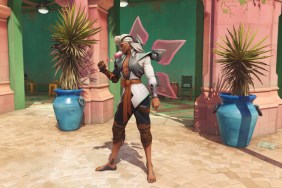The role of a lifetime.
Technically, the Elder Scrolls games are considered RPGs. Functionally, however, they share very little in common with the often linear Japanese games that dominate the genre. Their hallmark – truly open-ended gameplay set in absolutely immense worlds – is at once terrifying and enticing, promising seemingly endless hours of absorbing adventure but offering very little help along the way. It’s not for the weak at gamer heart.
It us, though, for GR. As fans of the Elder Scrolls series since it first destroyed our lives with 1996’s Daggerfall, we jumped at the chance to enjoy a day’s worth of hands-on time with the Xbox 360 version of The Elder Scrolls IV: Oblivion. In that time, we met with a doomed emperor, fought through a dungeon rife with traps, goblins, and giant rats, picked our astrological sign, chatted up a monk and did a million other things that, in the grand scheme, amounted to little more than an introduction to Bethesda’s upcoming RPGiant.
[image1]It would have been easy, for example, to spend the entire day playing with the game’s extremely deep character creation features. This content only affects your name, race and appearance, yet in true Elder Scrolls fashion, it’s capable of making hours pass like minutes. All the races from the great Morrowind are present and ready for adventure, including the ferocious Argonian lizardmen, frightening dark elves, hefty orcs, several types of humans and of course the frisky Khajit cat people. You can manipulate a dozen sliders for parts of your hero’s face you didn’t even know mattered. But they do, because they force you to consider your character’s identity before even taking a step in their shoes. You won’t just give your avatar a big or small nose; you’ll give them angrily flared nostrils or the straight, calm bridge of a righteous hero.
Whether you look fair or foul, you begin the game in a dank jail cell, which happens to be the setting for your unlikely run-in with the Emperor. You quickly gather that assassins have slain his heirs and are coming for him, and a secret escape route hidden in your cell is his only hope. When he spots you, he recognizes your face from his dreams. But hold onto your soap, because he’s been dreaming that you will somehow deliver his kingdom from the dark menace lurking beyond the gates of Oblivion (a cross between the Eye of Sauron and Warcraft‘s Dark Portal).
You follow him out of your cell and into the sewers where he predicts his own demise and almost immediately meets it, but not before bestowing you with vital information. From there, you’re on your own in a great big world with some vague directions and no boundaries. As you skulk or brashly bash your way through the dungeon beneath your prison cell, you decide the aptitudes and attitudes of you character by your style of play. Welcome to free-form heaven…or hell.
As you might imagine, all of your skills develop through use and repetition. If you constantly sneak around, your character will become ever better at sneaking. If you jump everywhere, your character will become athletic and gain abilities that suit his bouncy disposition, such as leaping strikes. This is old hat to Elder Scrolls veterans, but it’s still a great, open system that allows you to define your character instead of having it defined for you.
[image2]You still choose a birth star and class, but instead of limiting your character to certain behaviors, these grant new skills and improve the efficacy of old ones. For example, if you choose to be born under the Shadow Star and to be known as an assassin, you’ll gain the ability to turn invisible once a day from your star, plus improved damage on all of your sneak attacks as an assassin. The rest of your skills and abilities will be up to you to develop through play. Even the bonuses you receive for your class are customizable, and should you decide you don’t want to be a cat-faced stealth killer, you’re given the opportunity to change any choices you made regarding your appearance, race, star or class upon leaving the first dungeon.
Once outside, you’ll find yourself in a huge, open world with nothing to guide you but the cryptic instructions of the slain emperor. They direct you to a small monastery, and you can either get there by running (the directions of your main objectives appear on a compass), or by simply heading to the world map and clicking on the desired location.
If you decide to run around and explore your great big, wide world, you’ll run into a host of brigands, highwaymen and wild animals intent on thwarting your destiny. You can enter sneak mode to get the jump on any unaware enemies by clicking a single button, or you can clash head to head, putting your life in the able hands of Oblivion‘s improved combat system.
Blocking is now governed by a button press as opposed to being a passive attribute. There’s still a blocking skill, but now it decides how much of the damage is deflected from a successfully blocked attack instead of arbitrarily blocking for you. A good block will also deflect your foe’s weapon, leaving them vulnerable to a combo or power attack. In either case, your weapon won’t just magically miss your opponent as it would in Morrowind. If you smack your enemy upside his head with your axe, he’ll feel it every single time.
[image3]The interface has also been upgraded. Instead of going through the clumsy procedure of removing your bow and equipping your sword and shield, you can hotkey all of your weapon sets and spells to the eight directions on the D-pad. So shooting an arrow, breaking out your sword and shield, and then delivering a fiery coup-de-gras in the form of a flare spell are as easy as toggling your hotkeys and executing the commands. The whole system is smoother and more kinetic.
When you’ve had your fill of kicking brigand booty, you can head to a town and check out the shops, steal from the citizens, or just do whatever you fancy. All of the conversations are now voiced, making them seem much more natural than the Wikipedia style conversations from Morrowind.
Oblivion is also a much better looking game than its predecessor. The indoor environments are particularly impressive, with flames casting flickering shadows against walls, stones glistening with moisture, and strange blue lights ominously illuminating alien temples. Outside, things get a bit more rugged, as the terrain detail level drops sharply after only about a hundred yards. Don’t get your hopes up for many scenic vistas, but do expect to enjoy richly detailed character models, fearsome enemies and some extremely elaborate and atmospheric dungeons.
And expect to be blown away by this total package of an RPG. Few games demand the attention of any gamer confident enough to consider himself hardcore; there’s no doubt that Oblivion is about as intense as it gets. Whether you’re a PC or 360 gamer, start making shelf space for when the epic ships this Spring.











